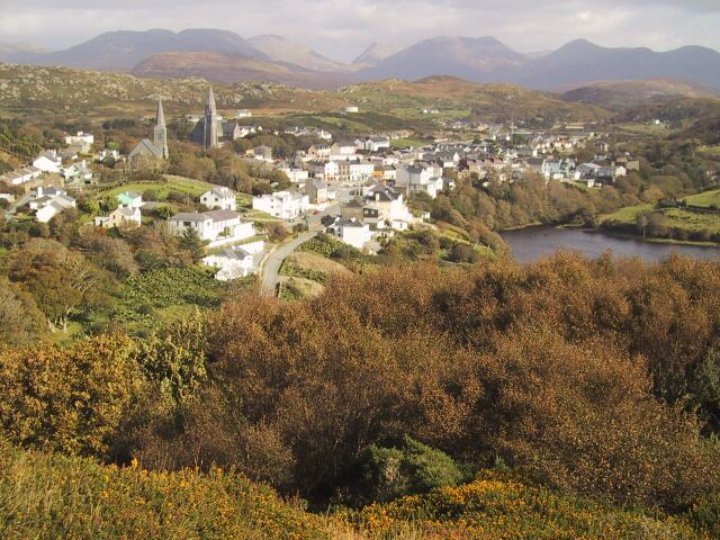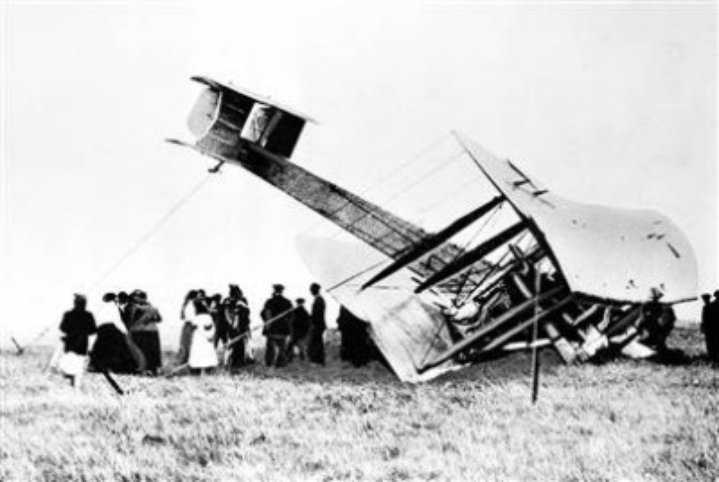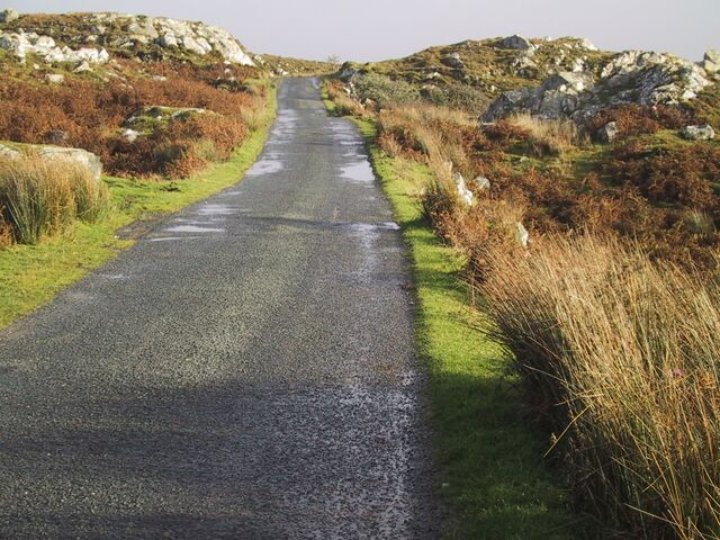“Where to?” I ask. “The bog road,” she replies, pulling her bike gloves on. “OK, I’ll catch you,” I say, distractedly. My attention is directed on the fiendishly difficult crossword sitting on my lap.
She’d come into the living room of our apartment in Clifden, on Ireland’s west coast, a moment before. Her eyes sparkled as she announced she was heading out on her bike. Good decision — we have to grab the dry weather while we can. We often head out in brilliant sunshine only to turn back 30 minutes later as black clouds suddenly appear in the west and, before you can say “Emerald Isle,” they empty themselves directly over us. Today could be different, though. The earlier rain had come and gone, and we could see clear skies way out over the ocean. Time for a longer ride. Time for the bog road.

Clifden, Ireland (Barry Evans).
We discovered the bog road two months earlier, the day we arrived in Clifden on Ireland’s west coast. Mid-morning had found us and our bikes sheltering in an old barn with an even older farmer while rain clattered down on the sheet metal roof. We appreciated the refuge, not so much for ourselves as for our stuff, our dry stuff: dry clothes, dry books, dry laptop. The deluge raging outside would have had little trouble insinuating itself into our bike bags. The farmer had seen us as we rode down his driveway as the first blast of the storm broke, opening his barn door without a word. Soon we were hearing about the harsh life of a Connemara sheep farmer struggling to keep abreast of taxes and bureaucracy.
Storm over, we stayed on our westerly course for the remaining few miles to the bog road, our final leg to Clifden. This is the same bog where, in 1907, Guiseppe Marconi built Europe’s first commercial wireless telegraph station at the edge of the western world. Twelve years later the station’s powerful transmitter did duty as a navigation beacon for John Alcock and Arthur Brown on completion of the first non-stop flight across the Atlantic. They sort of landed, sort of crashed, right next to Marconi’s station after their 16-hour, 2,000-mile flight from Newfoundland. The aircraft — a converted Vickers Vimy World War I biplane bomber — ended up nose down in the soft bog. You can see photos of it, tilted 45 degrees into the ground, on the wall of one of Clifden’s pubs. Another photo, taken in London a week later, shows a youthful Winston Churchill handing them a 10,000 pound prize check from the Daily Mail.

Alcock and Brown’s Vickers Vimy landing in the bog. (Daily Mail/public domain)
###
I wait until I hear her “Bye!” before I haul myself out of the armchair where I’d been struggling with the Guardian crossword. I have my pre-ride routine down pat by now: dress in old pants and tee shirt, my light boots that double here as bike shoes, hat and gloves; pack my rain jacket, digital camera, key to our flat; put in my contacts. Then it’s out the door on my old clunky-but-dependable mountain bike, and I’m chasing her south down the Ballyconeely Road to where it meets the bog road. From there the wind is at my back as I head east.
In minutes, I’m in the wild. No houses, no cars, no fences. Just the narrow, single lane strip of asphalt winding gently around granite outcroppings and shallow loughs. Through the bog.
A bog is wet, by definition. In most other ecosystems, plants rot when they die, but in a bog, the water prevents air getting to the dead vegetation under the surface, so instead of fully decomposing, it remains in a kind of suspended animation. This black, spongy material is peat, known locally as sod. A bog starts life as a swamp. Here in Connemara, the key ingredient for turning a swamp into a bog is native sphagnum moss, which lives happily floating on the surface. As it thickens, the floating islands of moss provide a home for other plants. Gradually a new ecosystem is created on which the vegetation, cut off by water from life-giving minerals and nutrients from below ground, thrives. Over the centuries, as new plants replace old, layers of decomposing vegetation build up below the surface in the dark, wet, acid environment. A peat bog is born.
###

The Bog Road (Barry Evans)
As I tear along looking for my buddy somewhere up ahead, I see the long lines of old peat cuttings on either side of the road. The Irish couldn’t wait for the millions of years it takes for peat to decompose into coal: they needed fuel, and they found it in abundance all over the island. Today, a scant ten percent of Ireland’s original peat bogs remain, and peat “mining” is now mostly limited to hand cutting for local use. Here on the bog road, the old scars are slowly healing.
A flash of blue. There she is, going like the clappers. She does love her bike, and I congratulate myself: I married well. Another five minutes of hard pedaling — she really is moving! — and I draw alongside. “Beautiful!” she cries. I agree, taking in the huge sky above, peat bogs surrounding us as far as we can see. Up ahead to the left, the two- thousand-foot-high hills known as the Twelve Bens fill the skyline. I try to imagine their formation millions of years ago, molten granite oozing year after year after year from a hot spot 20 or 30 miles beneath the earth’s surface. The magma cooled slowly into frozen oceans of rock, and then succumbed to eons of erosion to form the softly contoured gray breasts and thighs of the hills we now admire.
The back road from Ballynahinch to the Galway Road wends around loughs, through woods denuded of their summer foliage and across a couple of deep stream gulleys. We grin maniacally at each other, exhilarated, wind in our faces, sun dappling through the branches. No cars, nothing to intrude on our gratitude for this lovely Irish lane, for our bikes, for our bodies, for each other.
Awareness floods in. No past, no future, just this moment. I hear the sound of my own laughter.
CLICK TO MANAGE